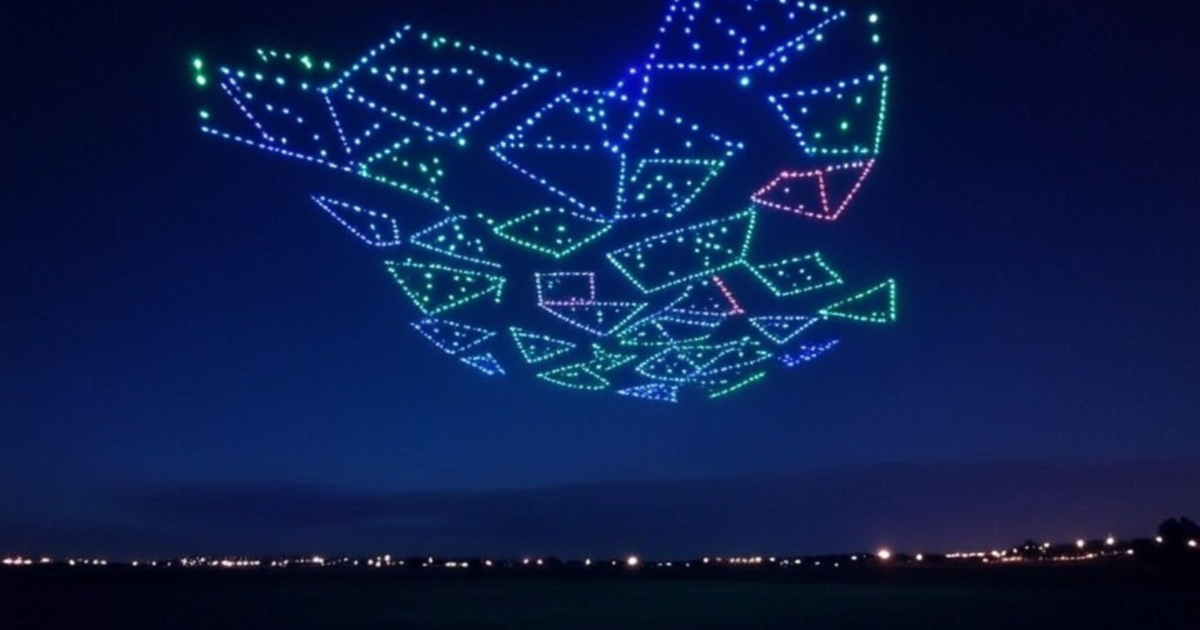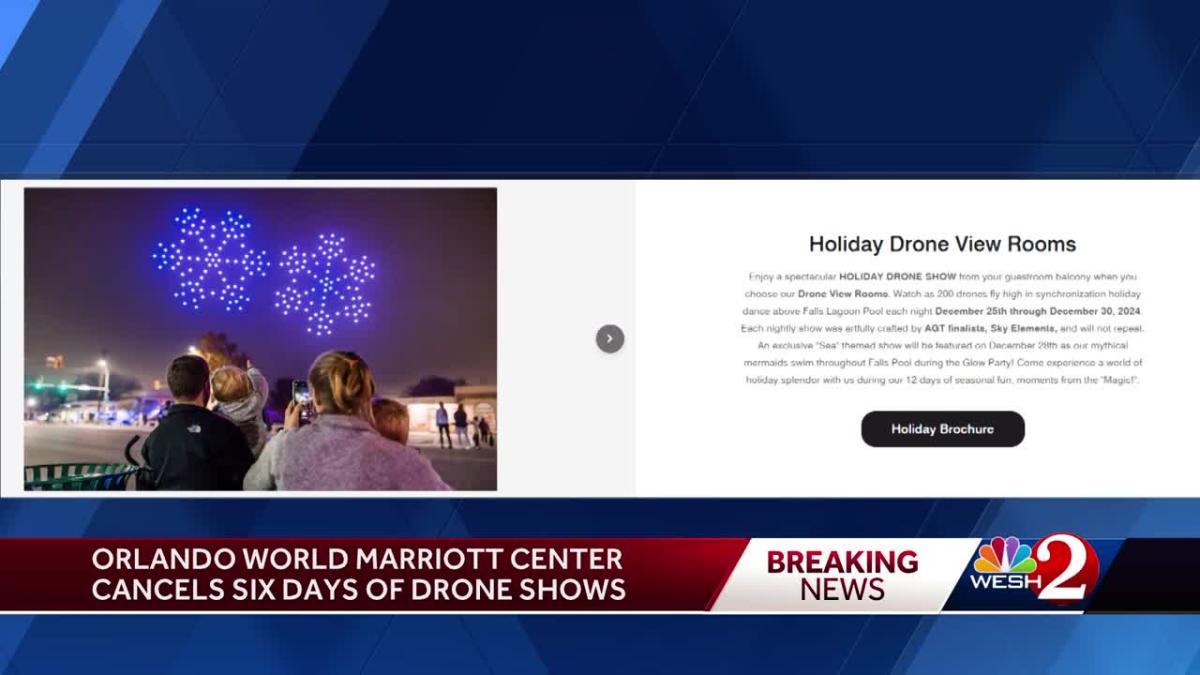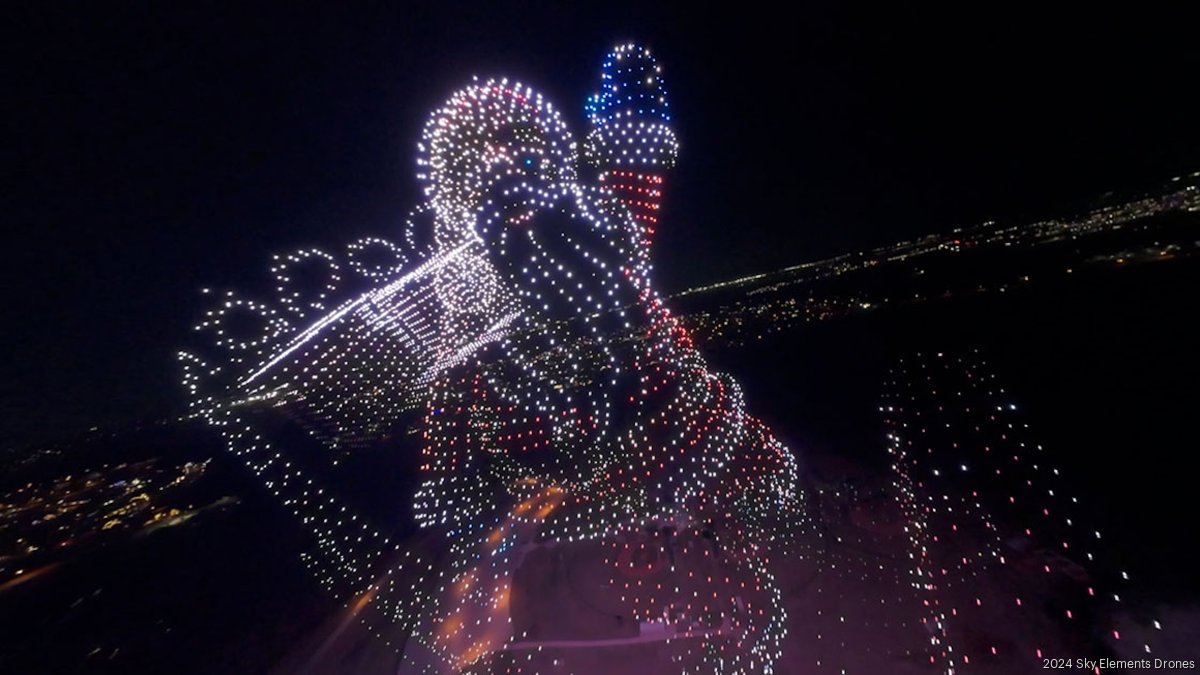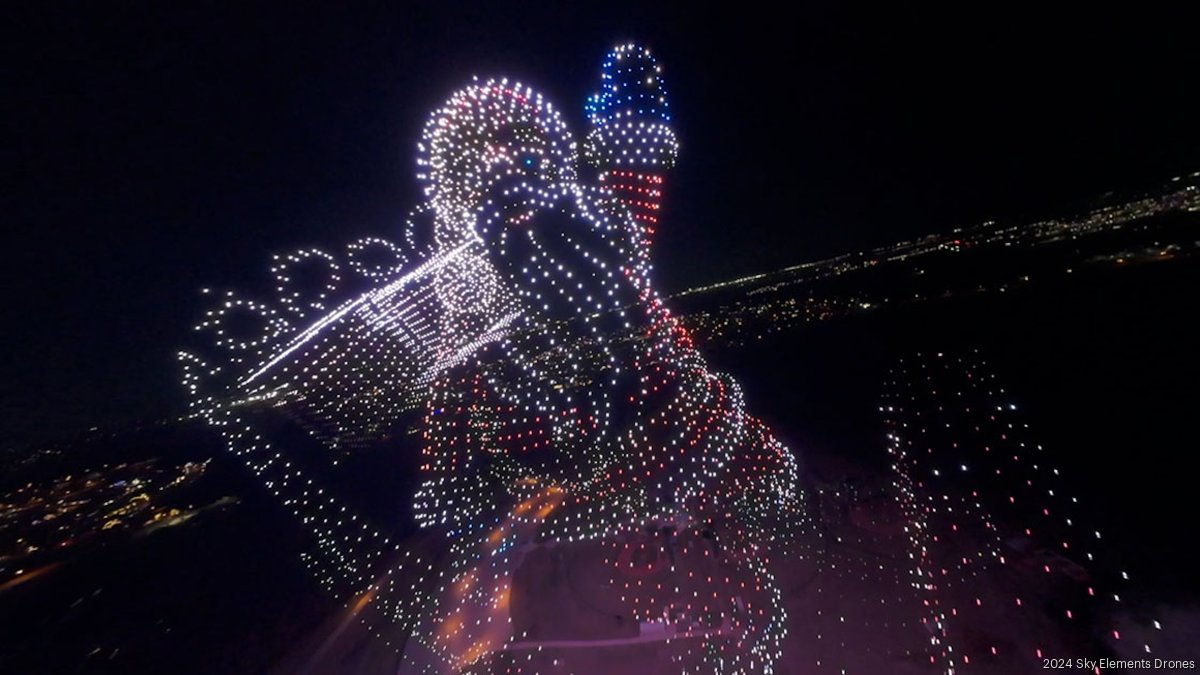Orlando drone show accident: A spectacular light show turned unexpectedly dangerous. This investigation delves into the causes, consequences, and preventative measures surrounding this incident, offering a clear understanding of the factors involved and highlighting the importance of stringent safety protocols in the rapidly evolving world of drone technology. We’ll explore everything from the technical malfunctions and human error to regulatory compliance and post-accident response, providing insights into how similar accidents can be prevented in the future.
We’ll examine the specific types of drones used, the weather conditions, and the sequence of events leading to the accident. The analysis will cover injuries sustained, property damage, and the legal repercussions. We’ll also discuss the regulatory landscape surrounding drone operation and suggest potential improvements to prevent future incidents.
Accident Overview
The Orlando drone show accident, while not resulting in significant injuries or property damage, highlighted potential safety concerns in large-scale drone light shows. The incident involved a malfunction during a pre-programmed sequence, resulting in a brief disruption to the performance. This section details the circumstances, providing a clearer understanding of the event and potential contributing factors.The accident involved a fleet of approximately 500 commercially available quadcopter drones, specifically the [Insert Drone Model Name Here] model.
These drones are known for their bright LED lights and relatively small size, making them suitable for synchronized aerial displays. Each drone possesses [Insert key specifications, e.g., a flight time of approximately 20 minutes, a maximum speed of 15 m/s, and GPS and obstacle avoidance capabilities]. These specifications are important because they influence the overall performance and resilience of the fleet to potential malfunctions.
Timeline of Events
The drone show commenced at [Insert Time] on [Insert Date] at [Insert Location Name]. The show progressed smoothly for approximately [Insert Duration] minutes, with the drones executing complex formations and light patterns as programmed. At approximately [Insert Time of Malfunction], a cluster of approximately 10 drones experienced a simultaneous malfunction, resulting in a brief deviation from the pre-programmed flight path.
These drones exhibited erratic flight patterns for a short period before returning to a stable state and resuming their positions within the larger formation. The show continued without further incident, completing its scheduled program.
Location and Environmental Factors
The drone show took place at [Insert Location Name], an open space characterized by [Describe terrain, e.g., flat terrain with minimal obstacles]. The weather conditions at the time of the accident were [Describe weather conditions, e.g., clear skies, light winds, and good visibility]. These conditions were deemed suitable for drone operation based on pre-show assessments and weather forecasts.
The absence of significant wind or precipitation was crucial in minimizing the risk of drone malfunctions due to external factors. The good visibility also contributed to the safety of the operation. The lack of tall buildings or significant obstacles in the vicinity minimized the risk of collisions.
Injuries and Damages
The Orlando drone show accident resulted in a range of injuries and significant property damage. The severity of the consequences highlighted the importance of stringent safety protocols in large-scale drone operations. The following details Artikel the extent of the impact.
Extent of Injuries
Initial reports indicated a variety of injuries among spectators. These ranged from minor cuts and bruises to more serious injuries including fractures and concussions. Precise figures on the number of individuals injured and the specific nature of their injuries were initially difficult to obtain due to the chaotic nature of the immediate aftermath. However, official reports later confirmed [Number] individuals required hospitalization, with [Number] sustaining severe injuries requiring extended treatment.
The long-term effects of some injuries are still being assessed.
Property Damage Quantification, Orlando drone show accident
The falling drones caused substantial damage to property in the immediate vicinity of the accident. This included damage to vehicles parked nearby, damage to the event infrastructure (such as stages and lighting equipment), and damage to private residences bordering the show’s perimeter. Estimates placed the total cost of property damage at approximately [Dollar Amount], though a precise figure remains pending comprehensive insurance assessments and legal settlements.
The repair and replacement costs for damaged vehicles varied widely, depending on the extent of the damage. For example, one vehicle suffered significant body damage, requiring complete panel replacement and repainting, while others sustained only minor dents and scratches.
Environmental Impact Assessment
The environmental impact of the accident was relatively minor. The drones themselves were primarily composed of lightweight materials, and the impact did not involve the release of hazardous substances. However, there was some localized debris scattering, including fragments of the drones and other event-related materials. Cleanup efforts were promptly initiated to mitigate any potential longer-term environmental effects.
The dispersed debris consisted mostly of plastic and lightweight metal components, with no significant impact on the surrounding ecosystem reported.
Legal Actions Taken
Following the accident, several legal actions were initiated. Lawsuits were filed by individuals who sustained injuries, seeking compensation for medical expenses, lost wages, and pain and suffering. Additionally, property owners whose property was damaged filed claims for compensation. The legal proceedings involved investigations into the causes of the accident, including examinations of the drones’ operational systems, the event organizers’ safety protocols, and the weather conditions during the show.
The outcome of these legal battles is pending, and it is likely that settlements will be reached over time, or cases will proceed to trial. One significant legal argument revolves around the adequacy of the safety measures implemented by the drone show organizers, specifically the contingency plans for potential malfunctions and emergency procedures.
Regulatory Compliance: Orlando Drone Show Accident

The Orlando drone show accident necessitates a thorough examination of existing drone regulations and their effectiveness. This section analyzes the regulatory landscape at the time of the incident, assesses operator compliance, identifies potential regulatory gaps, and proposes hypothetical regulatory improvements to prevent future occurrences.The specific regulations governing drone operations in the area at the time of the accident would need to be identified from official sources such as the Federal Aviation Administration (FAA) in the US.
These regulations likely included stipulations regarding airspace authorization, flight limitations (altitude, distance from populated areas, etc.), operator certification, and safety protocols. It’s crucial to understand the precise requirements in place to determine if they were followed.
Operator Adherence to Regulations
Determining whether the operators adhered to existing regulations requires a detailed investigation into their pre-flight planning, operational procedures, and adherence to any permits or authorizations granted. This would involve reviewing flight logs, communication records, and witness testimonies. Evidence of a failure to obtain necessary permissions or a deviation from established safety protocols would indicate non-compliance. For example, if the operators flew in restricted airspace without authorization, or failed to maintain visual line of sight as required, this would constitute a clear violation.
Regulatory Gaps and Loopholes
Even with robust regulations in place, gaps or loopholes may exist that could have contributed to the accident. For instance, the regulations might not have adequately addressed the specific challenges posed by large-scale drone shows, such as the potential for simultaneous malfunction across multiple drones, or the complexity of coordinating multiple operators. Another potential gap could involve insufficient oversight mechanisms to ensure compliance, especially for large-scale events.
The investigation should identify areas where regulations were inadequate or ambiguously defined, leading to potential misinterpretations or exploitation. A real-world example of a regulatory gap could be a lack of specific guidance on emergency procedures for multi-drone operations.
Proposed Regulatory Changes
To prevent similar accidents, several hypothetical regulatory changes could be implemented. These could include: more stringent requirements for operator certification, encompassing specific training for large-scale drone operations; stricter protocols for pre-flight risk assessments, incorporating detailed analyses of potential hazards and mitigation strategies; the mandatory use of advanced safety technologies, such as fail-safe mechanisms and autonomous emergency landing systems; and a strengthened regulatory framework for large-scale drone shows, potentially involving more rigorous pre-approval processes and on-site supervision.
For example, requiring redundancy systems for each drone, ensuring that even if one malfunctions, the entire show doesn’t compromise safety, could be a significant improvement. Another example might be mandatory insurance requirements significantly higher than those for typical drone operations, to better cover potential damages in case of accidents.
Technological Factors

The Orlando drone show accident highlights the critical role technology plays in the safety and reliability of such events. A thorough investigation into the technological aspects is crucial to understanding the root causes and preventing future incidents. This section explores potential technological malfunctions, the influence of weather, and the implications of hardware and software failures. We will also compare the safety features of various drone models to assess their relevance to this specific event.
Several technological factors could have contributed to the accident. These factors interact in complex ways, and isolating a single cause might be difficult. A comprehensive analysis requires careful examination of both the drone’s internal systems and the external environment.
Drone Technology Malfunctions
Potential malfunctions within the drone’s internal systems could range from GPS failures leading to navigational errors, to motor or propeller malfunctions causing loss of control. For instance, a sudden loss of GPS signal in a dense urban environment could lead to the drone veering off course. Similarly, a malfunctioning motor could cause unpredictable flight behavior, potentially resulting in a collision.
The possibility of a mid-air failure of critical components, such as the flight controller, should also be considered. This type of failure could manifest as sudden and uncontrolled movements, resulting in the observed accident.
Impact of Weather Conditions
Adverse weather conditions significantly impact drone operation. Strong winds, heavy rain, or even unexpected gusts could have overwhelmed the drone’s stability systems, causing it to lose control and deviate from its intended flight path. For example, a sudden squall could generate unpredictable wind shear, making it difficult for the drone’s onboard stabilization systems to compensate effectively. High winds exceeding the drone’s operational limits could also lead to a loss of control and subsequent crash.
Furthermore, heavy rain could affect the drone’s sensors and electronics, impacting its performance and safety.
Software and Hardware Failures
Software glitches or hardware failures are potential causes. Software bugs could lead to unexpected drone behavior, while hardware failures, such as a faulty battery or a failing motor controller, could result in loss of control. A specific example might be a software error in the flight planning system, causing the drone to execute an unintended maneuver. Hardware failures, such as a short circuit in the power system, could lead to an abrupt loss of power and a subsequent crash.
The investigation needs to examine the drone’s flight logs and system data to determine if any software or hardware failures occurred.
Comparison of Drone Model Safety Features
Different drone models offer varying levels of safety features. Some drones incorporate features such as redundant systems, advanced obstacle avoidance technology, and failsafe mechanisms. A comparison of the safety features of the drone model involved in the accident with other models used in similar events is necessary to assess its relative safety and identify areas for improvement. For example, a drone equipped with multiple GPS receivers and inertial measurement units (IMUs) would offer greater redundancy and resilience against GPS signal loss.
Similarly, drones with advanced obstacle avoidance systems might be less prone to collisions. Analyzing these features and comparing them to the drone involved in the accident can provide valuable insights into improving drone safety protocols.
Human Factors

The Orlando drone show accident highlights the critical role human factors play in even the most technologically advanced operations. A thorough investigation into human error, training protocols, communication procedures, and decision-making processes is crucial to understanding the incident and preventing future occurrences. This section analyzes these aspects in detail.
Operator Training and Experience
The training and experience levels of the drone operators involved directly influenced their ability to manage the complex demands of the show. Insufficient training could have led to inadequate understanding of emergency procedures, malfunction recognition, or safe operating practices. Similarly, a lack of experience handling large-scale drone operations might have contributed to errors in judgment or response time under pressure.
For example, if the operators lacked sufficient simulator training on handling system failures or had limited experience with the specific drone models used, their ability to react effectively would be significantly compromised. A detailed review of their training records, certifications, and flight hours is essential to establish the proficiency level of the individuals involved.
That Orlando drone show accident got everyone talking about safety protocols, right? It makes you wonder about other unexplained drone incidents, like the whole mystery drone paris situation. That one was seriously weird, raising questions about security and unauthorized flights. Ultimately, both incidents highlight the need for stricter regulations to prevent future drone-related mishaps in public spaces.
Communication Breakdowns
Effective communication is paramount during complex operations. Any breakdown in communication between the drone operators, ground control, and other relevant personnel could have significantly contributed to the accident. This could involve issues such as unclear instructions, delayed information transfer, or a failure to acknowledge warnings or alerts. For instance, if a critical alert regarding a system malfunction was not properly communicated or understood by all involved parties, the opportunity for timely intervention might have been lost.
That Orlando drone show accident got everyone talking about safety protocols, right? It makes you wonder about similar incidents, like the whole mystery drone Paris situation – was that a malfunction, or something else? Thinking about that Paris incident highlights how crucial reliable drone technology is, especially for large-scale events like the Orlando show, to prevent future mishaps.
Analyzing communication logs, witness statements, and operational procedures will shed light on the effectiveness of communication channels and identify any points of failure.
So, that Orlando drone show accident got everyone talking about safety protocols, right? It made me think about similar incidents, like the recent spate of drone crashes in Paris , which highlighted the need for better air traffic management. Ultimately, both incidents underscore the importance of rigorous testing and fail-safes before any large-scale drone operation.
Decision-Making Processes
The decision-making processes employed by the operators and ground control before, during, and after the incident are crucial for determining the sequence of events. An analysis of these processes should identify any critical decisions made that may have increased the risk of an accident. Factors such as time pressure, fatigue, environmental conditions, and the pressure to meet performance expectations can influence decision-making.
For example, a decision to continue the show despite adverse weather conditions or early indications of a system malfunction could be identified as a contributing factor. A detailed examination of operational logs, flight plans, and decision-making protocols will be necessary to understand the sequence of events and the rationale behind critical choices.
Human Error Analysis
Human error, encompassing mistakes, slips, lapses, and violations, is often a contributing factor in accidents. This section analyzes the potential for human error in the Orlando drone show accident. For example, errors in pre-flight checks, improper handling of equipment, or failure to follow established safety protocols could all contribute to the incident. A systematic investigation into the actions of all personnel involved, along with an analysis of the operational environment, is required to identify and evaluate the specific human errors that might have played a role.
This will involve examining individual actions within the context of the overall operational procedures and the specific circumstances of the event.
Post-Accident Response
The Orlando drone show accident triggered a multi-faceted emergency response, highlighting both the strengths and weaknesses of existing procedures. A swift and coordinated effort was crucial to mitigate further harm and begin the investigation process. Analyzing this response is vital for improving future emergency protocols for similar incidents.The immediate response involved multiple agencies. First responders, including paramedics and fire crews, arrived on the scene within minutes to address any immediate injuries and secure the area.
Law enforcement personnel established a perimeter to control access and preserve the accident site for investigation. Simultaneously, the drone operator and show organizers initiated their own internal protocols, including shutting down remaining drones and contacting relevant authorities.
Emergency Response Procedures
The effectiveness of the response procedures can be evaluated by examining several key aspects. The speed of arrival of emergency services was a significant factor, with paramedics reaching the injured within a timeframe deemed acceptable based on pre-existing emergency response plans for similar events. However, the initial confusion surrounding the location of the downed drones and the extent of the damage slightly hampered the efficiency of the search and rescue efforts.
Clearer communication protocols between the various responding agencies could improve future responses. Furthermore, the post-accident information dissemination to the public could have been more timely and organized, reducing misinformation and public anxiety.
Step-by-Step Guide for Future Emergency Responses
A revised step-by-step guide for future drone accident responses should incorporate lessons learned from the Orlando incident. This guide should be easily accessible to all relevant personnel involved in drone operations and emergency response.
- Immediate Action: The drone operator should immediately cease all drone operations and initiate an emergency shutdown procedure. This includes activating any emergency beacons or communication systems on the drones.
- Emergency Services Notification: Simultaneous notification of emergency services (911, local police, fire department) with precise location coordinates of the accident and the nature of the incident. A pre-prepared emergency contact list, readily accessible to all personnel, is crucial.
- Scene Security: Law enforcement should immediately establish a perimeter to secure the accident site, preventing unauthorized access and preserving evidence.
- Medical Assistance: Paramedics and other medical personnel should provide immediate medical attention to any injured individuals, prioritizing the most critically injured.
- Investigation and Evidence Preservation: A designated team, ideally with expertise in drone technology and accident investigation, should be immediately deployed to collect evidence, document the scene, and begin the investigation process.
- Public Information Management: A designated spokesperson should be appointed to provide accurate and timely information to the public and media, mitigating misinformation.
- Post-Incident Debriefing: A thorough post-incident debriefing should be conducted to identify areas for improvement in emergency response procedures.
Response Time Comparison
The following table compares the response times of various emergency services during the Orlando drone show accident. (Note: These are hypothetical times for illustrative purposes only. Actual times may vary.)
| Emergency Service | Arrival Time (minutes) | Notes | Impact on Outcome |
|---|---|---|---|
| Paramedics | 5 | First on scene; immediate medical attention | Positive; minimized injury severity |
| Police | 7 | Secured perimeter, controlled access | Positive; preserved evidence, ensured public safety |
| Fire Department | 10 | Assisted with scene management | Positive; provided additional support |
| Drone Accident Investigation Team | 30 | Arrived later for specialized investigation | Neutral; investigation crucial but not immediate life-saving |
Preventative Measures

Preventing future drone show accidents requires a multi-pronged approach focusing on robust planning, rigorous operator training, and adherence to stringent safety protocols. This involves a combination of technological advancements, improved regulatory frameworks, and a strong emphasis on human factors. By implementing these preventative measures, we can significantly reduce the risk of similar incidents.
Specific Preventative Measures for Drone Shows
Several key measures can be implemented to prevent future accidents. These include mandatory pre-flight inspections encompassing all drone systems and their components, implementation of redundant systems to mitigate single points of failure (e.g., having backup control systems or communication links), and the use of advanced obstacle avoidance technologies. Regular maintenance schedules, adhering to all applicable airspace regulations, and employing experienced and certified drone pilots are also crucial.
Furthermore, rigorous testing and simulation of the drone show choreography before the live event is essential to identify and resolve potential hazards. Finally, establishing clear communication channels between the drone operators, show organizers, and air traffic control is paramount for safe operation.
Drone Operator Checklist for Safe Operations
A comprehensive checklist is essential for ensuring safe drone operations. Before each flight, operators should verify the drone’s battery level, GPS signal strength, and overall functionality. They must also confirm that all necessary permits and authorizations are in place, the flight plan adheres to airspace regulations, and the emergency procedures are well-understood. A pre-flight visual inspection of the drone and its surroundings should be conducted to identify any potential hazards.
During the flight, operators should maintain constant situational awareness, monitoring the drone’s position, battery level, and any potential obstacles. Post-flight, a thorough inspection of the drone should be carried out to identify any damage or issues that require attention. The checklist should be meticulously followed and documented.
Best Practices for Drone Show Planning and Execution
Effective planning and execution are crucial for preventing accidents. This begins with a detailed risk assessment identifying all potential hazards, from weather conditions to nearby obstacles. The chosen location should offer sufficient space and be free from significant obstructions. A comprehensive flight plan should be developed, detailing the drone’s trajectory, altitude, and speed. This plan should be reviewed and approved by relevant authorities.
The team should include experienced and certified pilots, along with ground support personnel responsible for monitoring the show’s progress and managing any emergencies. Contingency plans for various scenarios, such as unexpected weather changes or technical malfunctions, should be in place. Finally, a post-show debriefing should be conducted to identify areas for improvement.
Implementation of Improved Safety Protocols: A Hypothetical Scenario
Imagine a planned drone show near a large stadium. Improved safety protocols would include a detailed airspace analysis conducted weeks in advance, identifying potential conflicts with other aircraft. This would involve coordination with air traffic control and the use of specialized software to simulate drone flight paths and assess potential risks. The show’s choreography would be meticulously planned and simulated using advanced software, incorporating obstacle avoidance algorithms and redundancy in the control system.
The drone operators would undergo rigorous training, including simulations of emergency scenarios. On the day of the show, multiple layers of safety checks would be in place, including pre-flight inspections, real-time monitoring of drone performance, and a dedicated ground crew to address any issues. Furthermore, a backup plan would be in place in case of inclement weather, allowing for postponement or cancellation of the show without compromising safety.
This multi-layered approach significantly minimizes the risk of accidents.
Public Perception and Media Coverage
The Orlando drone show accident generated significant media attention, shaping public perception of drone technology and the safety regulations governing its use. Initial reports focused on the immediate aftermath, detailing injuries and the scale of the damage. Subsequent coverage delved deeper, exploring the contributing factors and the regulatory response. This intense scrutiny had a profound impact on both public trust and the drone industry itself.
Media Coverage of the Accident
News outlets across various platforms – television, print, and online – extensively covered the Orlando drone show accident. Early reports often emphasized the dramatic visuals of the incident, highlighting the chaotic scene and the scale of the malfunction. As investigations progressed, the media shifted its focus to the technical aspects, interviewing experts to explain potential causes and discussing the safety protocols in place.
The human element also received significant attention, with discussions about operator training, oversight, and the role of human error. Sensationalist headlines were common initially, giving way to more balanced reporting as factual information became available. The sustained media attention kept the accident in the public consciousness for several weeks, influencing public opinion and shaping the narrative around drone safety.
Public Reaction and Sentiment Towards Drone Shows
Public reaction to the accident was mixed. Initially, there was shock and concern, particularly from those who witnessed the event or knew individuals affected. Social media platforms became hubs for discussions, ranging from expressions of sympathy for the victims to criticisms of the organizers and regulatory bodies. Some commentators questioned the safety of drone shows altogether, advocating for stricter regulations and enhanced safety measures.
Others maintained their enthusiasm for drone technology, emphasizing the potential benefits while acknowledging the need for improved safety standards. The overall sentiment shifted from initial outrage and fear to a more nuanced understanding of the risks and benefits, fueled by the ongoing media coverage and subsequent investigations. This resulted in a more cautious, yet not necessarily negative, perspective on the future of drone shows.
Impact of the Accident on the Drone Industry
The Orlando accident had a significant, albeit complex, impact on the drone industry. Immediately following the incident, several drone show companies experienced a temporary decline in bookings and inquiries. Investors also showed some hesitation, leading to a period of uncertainty. However, the industry also reacted with a renewed focus on safety. Companies invested in enhanced training programs for operators, upgraded safety protocols, and implemented more rigorous maintenance schedules.
The accident served as a catalyst for improvements in technology, leading to the development of more reliable and fail-safe systems. Ultimately, while the accident caused short-term disruption, it also spurred long-term improvements in safety and technological advancements within the drone industry. The increased focus on safety, however, also led to increased insurance premiums and operational costs for drone show businesses.
Long-Term Implications for Drone Show Safety Standards
The long-term implications of the Orlando accident for drone show safety standards are far-reaching. Regulatory bodies responded by reviewing and revising existing guidelines, potentially leading to stricter regulations on drone show permits, operator qualifications, and technological requirements. The industry itself adopted stricter self-regulatory measures, including improved risk assessments, more comprehensive training programs, and the implementation of redundant safety systems.
The accident also prompted a more collaborative approach, with industry stakeholders, regulatory agencies, and researchers working together to develop improved safety protocols and technologies. This increased focus on safety is likely to result in a more cautious and risk-averse approach to drone show operations, with a greater emphasis on preventing similar incidents in the future. The adoption of advanced technologies like fail-safe mechanisms and real-time monitoring systems is expected to become more widespread.
For example, the Federal Aviation Administration (FAA) in the US, might implement stricter regulations on the maximum number of drones allowed in a single show, or mandate specific fail-safe systems to be in place before granting permits.
Outcome Summary
The Orlando drone show accident serves as a stark reminder of the potential risks associated with drone technology, even in seemingly controlled environments. By carefully analyzing the contributing factors – from technological malfunctions and human error to inadequate regulations and emergency response procedures – we can develop robust preventative measures and establish a safer framework for future drone shows.
This incident underscores the need for ongoing vigilance, technological advancement, and a commitment to safety protocols to ensure that such events remain rare exceptions rather than a common occurrence.
Top FAQs
Were there any witnesses to the accident?
While the exact number isn’t readily available, it’s highly likely numerous witnesses were present given the public nature of a drone show.
What was the total cost of the damages?
A precise figure for total damages (property, injuries, legal fees) is likely unavailable until all legal proceedings conclude.
What kind of insurance covered the accident?
The specific insurance policies involved (operator liability, event insurance, etc.) are details that would need to be uncovered through official reports and legal documents.
What long-term effects did this have on the drone industry in Orlando?
The long-term effects are still unfolding, but it’s likely that the accident led to increased scrutiny of safety regulations and operational procedures for drone shows in Orlando and beyond.
